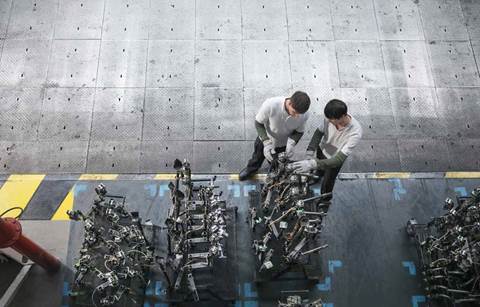As we head into 2021, we have many reasons to be optimistic about the coming year. Middle-market manufacturers have continued to thrive in the current environment despite the tremendous challenges brought by the COVID-19 pandemic. Businesses engaged in e-commerce and those leveraging advanced manufacturing technologies, in particular, have been — and are very likely to continue to be — successful.
Interest rates remain low, creating a solid environment for borrowing and leveraging. Healthy companies can enjoy the availability of capital and financing. Deal activity in the investor market continues to accelerate, creating both acquisition and divestiture opportunities. Energy costs remain relatively low by historical standards and consumer confidence, while somewhat decelerating in recent months, will finish the year at a much higher level than early 2020.
That’s not to say we won’t face headwinds in the form of lingering and widely varying impacts from the pandemic and ongoing talent shortages. On the global stage, we’re seeing increasing competition and consolidation, challenging the growth of businesses that lack adequate capital.
With the potential for recently approved vaccines to see broad distribution in the coming months, we expect a year marked by the loosening of pent-up demand and new opportunities for businesses to identify their competitive advantages and embrace innovation and reinvention.
What else lies ahead? Here are a few themes and trends likely to impact middle-market manufacturers in 2021 and beyond.
Economic outlook
Our outlook is optimistic for the new year, but we’ll offer one caveat. We’re seeing a number of signs that the incredibly robust third-quarter 2020 rebound has decelerated sharply. There’s been an uptick in layoffs and a slowdown in consumption, contributing to an inflating view that growth could slow further or even turn negative — albeit potentially for a comparatively brief period similar to last spring — in the near term. Without the pandemic, we would expect to see a smoothing out of that robust third-quarter rebound to a level modestly above trend before settling into a long expansionary cycle. But with recent signs of another COVID-19 resurgence and reimposed or extended restrictions in various parts of the country, we anticipate further dampening as a consequence. Expect for some tougher sledding in the first quarter.
From there, the picture brightens. We expect more fiscal support out of Washington D.C., even after the two parties recently coalesced around a deal to help sustain household spending. And low interest rates make it an opportune time for an infrastructure bill, although it’s not clear where that is prioritized on the legislative agenda. The bottom line is that fiscal support should act as a significant positive catalyst for the economy once the near-term risk subsides.
Recovery, strategy, and operations
Prior to the COVID-19 pandemic, we had a 10-year run of expanding economic development. Many middle-market businesses grew and earned record profits. But a rising tide can hide weaknesses, and COVID-19 consequently exposed them. Federal support in the form of Paycheck Protection Program (PPP) loans helped many companies, but we expect a shakeout in at least the first half of the year. Issues with liquidity, leadership, customer retention are bound to impact near-term viability.
Labor will continue to be a pain point for manufacturers, one that’s been exacerbated by COVID-19. We’re seeing an interestingly frustrating dynamic in which the talent gap remains, especially for skilled operators of complex equipment, despite high unemployment. While opinions may vary, a combination of pandemic-related starts and stops for industrial companies, coupled with certain governmental incentives that in part create a conflict for employees to return to their jobs, have clearly generated turbulence in the workforce.
Many middle-market manufacturers are addressing the skilled labor shortage through technology, including robotic process automation. In fact, labor is a key driver of increasing adoption of Industry 4.0 technologies. Another driver in many sectors is the customer. Take the new cybersecurity standards for defense contractors as an example. Customers are requiring firms to interact via enhanced technologies, and the new standards call for an external audit to demonstrate compliance. If you’re not keeping up with the ever-changing cybersecurity environment, you’re putting business operations, financial performance, and customer relationships at risk.
Global competitiveness
Tariffs and trade are top of mind as we head into the year. Clients are asking if we expect a major rollback in tariffs, particularly on steel and aluminum. The answer is no, we don’t.
That said, we don’t foresee additional tariffs, but rather a potentially more diplomatic, multilateral approach to trade and recalibrated collaboration with allies. We might see, for example, increased contact with India, which like the United States, isn’t part of the recently signed Regional Comprehensive Economic Partnership trade agreement.
There’s been much discussion in the middle market about reshoring. We believe we’ll see encouragement — and perhaps some targeted initiatives, such as in the area of personal protective equipment — but if you’re waiting for broader reshoring incentives, don’t. There’s a real emotional draw to the idea of reshoring, and in some cases, it’s a good business move. In other cases, near-shoring to Mexico, for example, is the more strategic play, especially with the USMCA in place.
Where we do expect to see strong incentives is for job creation to support exports. If you’ve been waiting to dip a toe into international waters, this year will be a good time to revisit export platforms and strategies related to expansions abroad.
After a couple of years of declining foreign investment in the United States, we’re now seeing an uptick. Middle-market manufacturers should be prepared to start marketing opportunities they may have for foreign investors. With the global economy recovering next year, the U.S. dollar will face more downward pressure as investors opt for riskier assets and the Federal Reserve keeps rates near zero, according to analysts.
Here’s one more question we’re often asked: How much should middle-market manufacturers focus on supply chain? Our answer might surprise you: Not so much; don’t overreact. Surveys among companies invested in Asia, namely in China, show these companies don’t have plans to make significant changes. While diversification to other Asian countries will continue as trade policies and business climates mature, the data make sense; expansion opportunities for many manufacturers, over time, will be in Asia.
Tax matters
We saw a number of COVID-19-related tax changes in 2020. These included increased and accelerated deductions, loosening of the business interest expense limitation, enhanced deductibility of charitable contributions, and the ability to carryback net operating losses. Business incentives included payroll tax credits, payroll tax deferral, and PPP loans. Given the continuing pandemic environment and current nonpartisan views and support for renewed stimulus programs, we’ll likely see further tax benefits or additional incentives. Manufacturers should continue to monitor legislative developments for the continuation or expansion of 2020 programs and possibly new tax incentives.
One issue that has gotten a lot of attention is the deductibility of qualified expenses paid for with income from PPP loans. Earlier in 2020, the IRS ruled that, while PPP loans that are forgiven result in tax-exempt income, the expenses paid for with those funds are nondeductible. Recently passed legislation, which allows the expenses to be deductible, should have a positive cashflow impact on businesses struggling to gain traction through the latter stages of the pandemic.
As for other potential tax law changes, key topics to monitor include the corporate income tax rate, qualified business income deduction, business interest expense limitation, international tax regimes, and any new incentives for onshoring manufacturing. The outcome of the Senate runoff elections in Georgia will be crucial to determining the balance of power in the Senate and, by extension, the likelihood of significant tax proposals.
In conclusion
We’re starting off the new year with a sense of tempered optimism. Many healthy businesses that have been holding back on growth plans are now about to move forward in response to pent-up demand and new opportunities.
The key over the course of the year will be to stay nimble, leverage technology and innovation, and be ready to adapt quickly to unforeseen changes. As your operations and product mix change, it will be especially critical to understand the real impacts and your specific competitive advantages (and potential risks) in order to grow strategically and ensure success.
Want to learn more about the impacts on your business as you stretch your capabilities and level-set for increased sales and growth? Compete in the global marketplace? Plan smartly for new tax changes and incentives? As always, we’re happy to share our perspective with you. Feel free to give us a call.





